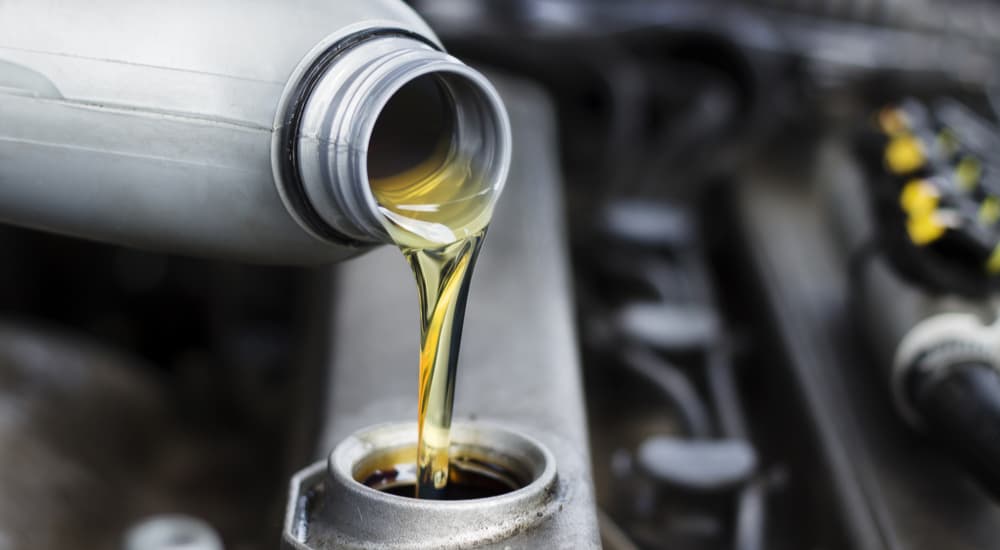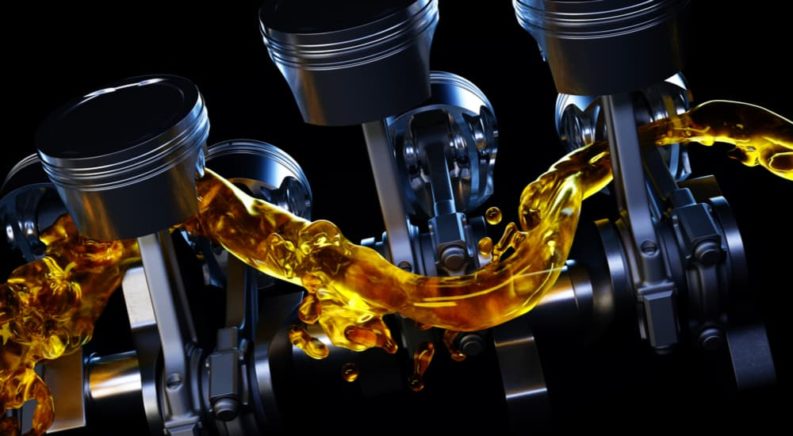Oil changes are one of the most vital forms of maintenance for your vehicle, but not all motor oil is created equal. It all comes down to viscosity ratings. In basic terms, viscosity means how thick a liquid is due to its internal friction. Simply pour a bottle of water and a bottle of honey into shallow dishes, and you’ll see the effect in real-time. The water will quickly spread out to evenly fill the surface due to its very low viscosity, whereas the honey will initially pile up on top of itself, slowly spreading out to fill the area due to its relatively high viscosity.
Viscosity can vary drastically between different liquids, even to the extent that it might not seem like a liquid at all. We tend to think of a pretty narrow swath of viscosity when we’re picturing liquids: water, gasoline, and of course, motor oil, but there are some substances that might not seem to fit the definition at first glance. Resin, for example, is technically a liquid; it just has such high viscosity that its flow is hardly perceptible. It still retains all the same properties, however.
That’s all great, but since you’re not about to mistakenly put honey or resin in your oil tank, what does any of this have to do with vehicles? Well, motor oil comes in a varying degree of viscosities, with specific formulations providing important advantages and disadvantages over others. While the difference between motor oils is nowhere as drastic as that between, say, water and peanut butter, it’s still important to ensure you’re using the correct oil based on your vehicle’s make, age, and typical driving conditions.

What Are Viscosity Ratings?
There’s some technical jargon to unpack here, so let’s start at square one. Thinner motor oils are better for winter temperatures, reducing friction and making it easier for engines to start up in colder conditions. Thick oils, in contrast, are better for warm weather, providing the high film strength and oil pressure needed to keep engines chugging along smoothly. Oil viscosity is expressed using four characters and always follows the same formula: a number, a letter, and a hyphen followed by another number. Developed by the Society of Automotive Engineers (SAE), this grading system ensures your engine operates within the specific viscosity grade it was designed for. 5W-30 is the most common motor oil viscosity used in contemporary vehicles, so let’s pick that classification apart a little to see what it means.
The characters to the left of the dash represent the motor oil winter viscosity rating, with the lower number indicating better performance in low temperatures and vice versa. For example, an oil with a 5W-30 rating will flow more easily in cold temperatures than one with a 10W-30 or 15W-30 rating. This number is derived by measuring the oil’s viscosity when a vehicle is being operated below zero degrees Celsius. In contrast, the number after the dash indicates the motor oil’s viscosity when being operated at 100 degrees Celsius, effectively providing drivers with a warm-weather rating that demonstrates the oil’s ability to resist thinning when the temperature starts to rise. Again, this means that motor oil with a 5W-40 rating will flow better at higher temps when compared to 5W-30 oil.
There’s a specific reason the SAE has provided drivers with these specific ratings derived from two very different temperatures. The first represents the conditions a vehicle might encounter when first being fired up, which can range from anywhere between -20 and 100 degrees Fahrenheit depending on your latitude. The second number, measured at 100 degrees Celsius (212 degrees Fahrenheit), expresses the viscosity at the temperature most engines will achieve when fully warmed up, usually between 195 and 220 degrees Fahrenheit.
If this seems a little abstract, there are some everyday analogies that can help drive the concept home. Think of honey again, for example, and its tendency to thicken or resist flow at colder temperatures. If you’ve ever struggled to sweeten your tea in your frosty early-morning kitchen in January, you’ll know exactly what we’re talking about. The concept is even more pronounced when discussing something like glass or steel: at very high temperatures, it returns to a liquid or “molten” state, whereas it’s a solid once it’s cooled down.
Common motor oils like 5W-30 are what’s known as multi-weight oils. This is in contrast to straight-weight oils (SAE50, SAE30, etc.), which are typically only used on smaller engines and older vehicles. The main difference between the two is that multi-weight oils can effectively maintain their viscosity as engine temperatures rise thanks to modern additives, whereas a straight-weight oil will thin out as a vehicle gets up to operating temps. This flexibility is a major advantage over straight-weight oils, and multi-weight oils should always be used in modern vehicles.

Why Are They Important?
Logically, it might seem as if a thicker oil is always preferable to a thinner mixture. After all, who wouldn’t want a thicker coating of oil lubricating their engine’s vital components? While it’s true that it’s generally better to err on the thicker side, this does have some downsides. High-viscosity motor oil will not only perform worse in low temperatures, but it will also degrade faster due to the increased operating temperatures it causes. In addition, thicker motor oil increases overall fluid friction within the engine, reducing fuel efficiency and leading to lower MPG.
Lower viscosity oil brings its own pitfalls and can prematurely age a vehicle due to an inability to lubricate the engine properly. This can lead to more wear-and-tear, as thinner oil allows more direct metal-to-metal contact. It will also burn off much quicker, which is not only more expensive but also causes deposits that can tax your vehicle’s evaporative emissions control (EVAP) system. This thinner oil can also leak through some of the engine’s looser seals, potentially causing a mess and requiring frequent top-offs. To sum it all up, it basically comes down to a trade-off between fuel economy (and ability to start in cold temps) and long-term engine protection.
Oil viscosity recommendations have been steadily dropping over the years: while 10W-40 was once the most common blend on the market, only two percent of today’s vehicles still use that weight. As we mentioned, 5W-30 is now the standard-bearer, representing 56 percent of vehicles, but recently there has been a trend towards using even lower-viscosity motor oil in new vehicles, with major brands such as Toyota and Honda recommending ultra-thin 0W-20. There are multiple reasons for this downward trend, though the goal of increased fuel economy is the main culprit as auto manufacturers aim to meet increasingly stringent corporate average fuel economy (CAFE) requirements. While this can lead to premature wear on some components, the thinner oil can actually improve the performance and longevity of parts like the oil pump, which is less taxed when pumping the lower-viscosity oil.
Remember, your vehicle’s manual will specify the specific motor oil to be used, maybe a couple if you’re likely to encounter particularly cold conditions. There’s a lot of fun to be had in customizing your ride, but motor oil is one area where it’s perfectly fine to go with the flow and stick with the manufacturer’s recommendations. Unless you are a motor oil expert, the odds are you will do far more harm than good by not using the oil viscosity recommended for your engine.

